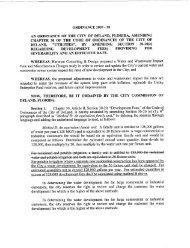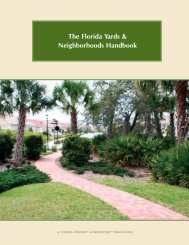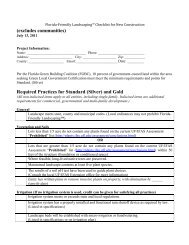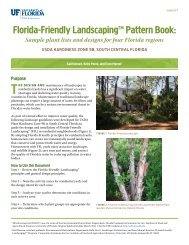A Guide to Florida-Friendly Landscaping A Guide to Florida-Fr ...
A Guide to Florida-Friendly Landscaping A Guide to Florida-Fr ...
A Guide to Florida-Friendly Landscaping A Guide to Florida-Fr ...
Create successful ePaper yourself
Turn your PDF publications into a flip-book with our unique Google optimized e-Paper software.
A healthy, properly maintained lawn absorbs s<strong>to</strong>rmwater runoff, protecting<br />
<strong>Florida</strong>’s natural waters. If s<strong>to</strong>rmwater runoff is not absorbed and contains<br />
unused nitrogen and phosphorus from fertilizers, when these chemicals enter<br />
natural waterways, they can fuel abundant algal blooms that smother natural<br />
vegetation, deplete oxygen and possibly kill fish. These nutrients, if applied<br />
improperly, can cause invasive weeds <strong>to</strong> flourish, changing <strong>Florida</strong>’s natural<br />
plant communities. More alarming, potentially harmful substances, such as<br />
common household pesticides and fertilizers, are leaching in<strong>to</strong> our water<br />
supply. These materials damage aquatic life and harm people, <strong>to</strong>o. These<br />
substances that are washed from and through soil in s<strong>to</strong>rmwater runoff form<br />
NPS pollution.<br />
Following FYN landscaping guidelines will reduce nonpoint sources of<br />
pollution. A properly designed and managed landscape can help slow down<br />
and filter s<strong>to</strong>rmwater runoff.<br />
Making Every Raindrop Count<br />
One of the basic concepts of a <strong>Florida</strong>-<strong><strong>Fr</strong>iendly</strong> Yard is that rain that falls in your<br />
yard should soak in<strong>to</strong> your yard. After all, rainfall is an excellent water source for<br />
your landscape, and reducing runoff protects waterways. Retaining rainfall long<br />
enough for it <strong>to</strong> percolate through soil is<br />
challenging in neighborhoods built on<br />
compacted fill soils. Consider these practical<br />
tips for reducing the amount of rainfall that<br />
runs off your yard.<br />
■<br />
■<br />
Downspouts. If your roof has rain gutters,<br />
aim the downspouts at a porous surface<br />
so water can soak in<strong>to</strong> soil. Be sure water<br />
doesn’t pool next <strong>to</strong> buildings.<br />
Helpful hint: If you decide <strong>to</strong> landscape<br />
the area where downspouts drain, choose<br />
plants adapted <strong>to</strong> wet/dry extremes.<br />
Earth Shaping. Incorporate attractive,<br />
functional earth shaping in<strong>to</strong> your<br />
Downspout directed in<strong>to</strong> the yard.<br />
landscape. Swales (small dips in the<br />
ground) and berms (raised earthen areas) can help divert runoff that would<br />
otherwise rush from your yard. A densely growing turfgrass or groundcover<br />
purchased iS<strong>to</strong>ck pho<strong>to</strong> image<br />
http://www.dep.state.fl.us/water/nonpoint/<br />
93














